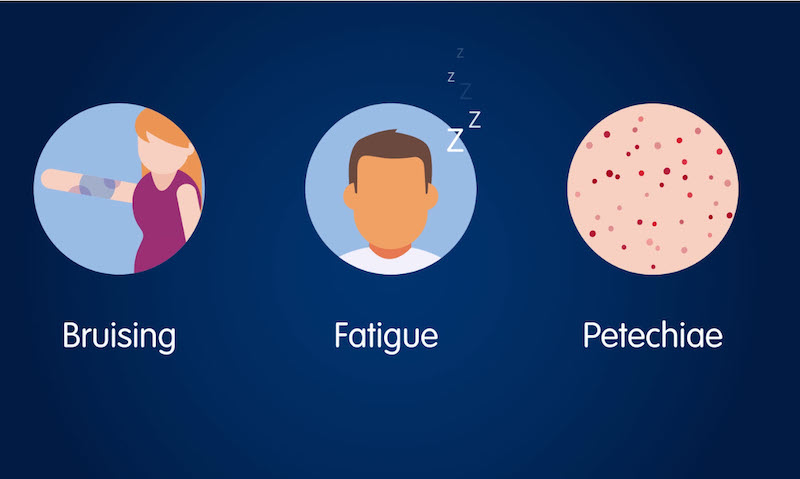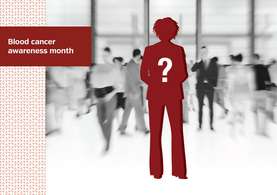September 20-24, Global ITP Awareness Week
In the campaign to raise awareness of blood diseases, enabled by Novartis, today we raise awareness of an early diagnosis of primary immunethrombocytopenia (ITP), as today begins the Global ITP Awareness Week, dedicated to this rare disease characterized by a low platelet count in the blood. Primary immune thrombocytopenia causes bleeding, and the patients are often more tired.
“ITP most often causes subcutaneous bleeding. It canappear as tiny red dots named petechiae or purpura if the dots are larger. Somepatients have bleedings in the oral mucosa, but they can also bleed from thegums and nose, have blood in urine and stool, and female patients can experienceheavy menstrual bleeding. Intestinal bleedings are more threatening to thepatient’s life and health, and the most dangerous is the central nervous systembleeding. Luckily, both are extremely rare, and happen with a very low plateletcount in the blood. ITP patients are often more tired,” said Barbara Skopec, PhD, internist andhematologist at the Department of Hematology of the Internal Clinic at theUniversity Medical Center Ljubljana.
Symptoms of ITP
 Platelets or thrombocytes are one of thethree types of blood cells. They are involved in blood clotting and stopbleeding. They accomplish this by sticking together and forming a plateletplug. ITP causes an immune reaction in the body in which antibodies are createdagainst the body’s own platelets. These antibodies bind to platelets and causethem to fall apart.
Platelets or thrombocytes are one of thethree types of blood cells. They are involved in blood clotting and stopbleeding. They accomplish this by sticking together and forming a plateletplug. ITP causes an immune reaction in the body in which antibodies are createdagainst the body’s own platelets. These antibodies bind to platelets and causethem to fall apart.
The causeof ITP is (still) unknown
“We are most often unable to explain what causesthe immune reaction and the subsequent thrombocytopenia. It could be caused bydifferent medications (even over-the-counter medications from the pharmacy),viral infections, infection with the Helicobacter pylori bacteria, and otherblood or cancer diseases. Immune thrombocytopenia can occur with other diseasesthat affect the immune system, such as rheumatic diseases. In this case, wecall it secondary immune thrombocytopenia,” explained Dr. Skopec.
Primaryimmune thrombocytopenia is equally common in men and women and both young andold people, and it is twice more common in women in the middle age group. Thedisease can also appear during pregnancy.
“Regardless,pregnancy is usually normal and childbirth is safe, and the newborn baby has noissues. Naturally, in such cases hematologists and obstetricians are especiallyalert,” pointed out Dr. Skopec.
Estimationson the number of people affected by immune thrombocytopenia vary. The lateststudies show that this disease each year affects 3.3 out of 100,000 adults and4.3 to 5.3 out of 100,0001 children. The disease prevalence (numberof patients, old and new) is estimated at approximately 9.5 cases out of100,000 adults, and among children, it is similar to the number of casesdiscovered each year because children with ITP usually recover1
ITP-relatedfatigue affects the quality of life
Theinternational study iWISh2 was published this year in the renownedmagazine »American Journal of Hematology«. The study analyzed the burdens,related to ITP, and effects of this disease on patients’ quality of life. 1507patients and 472 doctors from 13 countries participated in the study. At thetime of the diagnosis, 58% of patients reported fatigue as one of the mostcommon symptoms of the disease, and 73% of patients even reported heavyfatigue. The burden of fatigue caused by ITP has a significant impact on thequality of life2.
Most ITPpatients do not need treatment.
“We decideon treatment based on the platelet count in the blood, patient’s age, previousdiseases, life style, potential expected adverse events related to thetreatment,” said Dr. Skopec.
Treatmentsvary. If the cause of thrombocytopenia is discovered, the cause is treated orremoved, otherwise treatment is symptomatic.
“The firstchoice of treatment is glucocorticoids; if they are contraindicated or if thepatient has mucosal bleeding, treatment with intravenous immunoglobulins isanother option. If the disease recurs too quickly despite the treatment, thenext choice are thrombopoietin receptor agonists, anti CD20, or otherimmunosuppressive medications. In extreme cases, the treatment is surgical –removal of the spleen. Patients with low platelet count and clinically relevantbleeding are also treated with platelet concentrate transfusions,” describedDr. Skopec.
The iWISh study’sresults also revealed that patients’ satisfactions was higher when treated withthrombopoietin receptor agonists (TPO-RA) and with anti CD20 instead ofcorticosteroids. An early switch from corticosteroids to second-line treatmentcan reduce adverse effects and improve quality of life3.
Supportallows most patients to live fully their lives
Since manyITP symptoms are invisible, regular examinations and consultations withhealthcare professionals and other people who may be able to support them intheir life with the disease are important for the patients. Most ITP patientscan live a full and productive life if provided appropriate treatment.
InSlovenia, next to healthcare professionals, support is given by the Association of Patients with Blood Diseases Slovenia and the Slovenian Association of Patients with Lymphoma andLeukemia, L&L.
Vacation is over, and you are still tired?
If we experience heavy fatigue even after a long vacation and without anything causing it, we must find a reason for it with the assistance of our physician. Fatigue is one of the common symptoms of numerous blood disorders, which includes ITP.
The signs and symptoms of blood disorders are very general, which is why the discovery of blood diseases is difficult and often they do not get enough attention. One things holds true for all blood diseases: an early discovery is very important for the success of treatment and the survival of patients.
The campaign in September, the Blood Cancer Awareness Month, is organized in cooperation with the Association of Patients with Blood Diseases Slovenia and the Slovenian Association of Patients with Lymphoma and Leukemia, L&L, with expert support of hematologists and oncologists. The campaign was made possible by Novartis.

Sources:
1. Website of the International ITP Alliance. Accessible at: https://www.globalitp.org/ Last accessed on September 1, 2021
2. Cooper N, Kruse A, Kruse C, et al. Immune thrombocytopenia (ITP) World Impact Survey (iWISh): Patient and physician perceptions of diagnosis, signs and symptoms, and treatment. Am J Hematol. 2021;96:188–198.
3. Susan D. Mathias. I-WISh: A wish list for immune thrombocytopenia quality of life indicators becomes reality. Am J Hematol. 2021;96:172–173.
For more information please contact:
Katarina Klemenc
Head Communications and Patient Engagement
Phone: +386 1 580 22 43
katarina.klemenc@novartis.com

